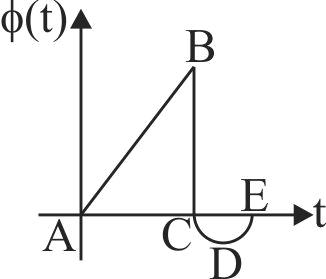358632 A rectangular, a square, a circular and an elliptial loop, all in the \(xy\)-plane, are moving out of uniform magnetic field with a constant velocity, \(v=v i\). The magnetic field is directed along the negative \(z\)-axis direction. The induced emf, during the passage of these loops, out of the field region, will not remain constant for
358636 A square loop of side \({a}=10 {~cm}\) with its sides \(v=8 {cms}^{-1}\) parallel to \(x\)- and \(y\)-axis is moved with velocity \(v = 8\,\,cm{s^{ - 1}}\) in the +ve direction of \(x\)-axis. There is a magnetic field with gradient of \(0.10 {Tm}^{-1}\) along the negative \({x}\) direction and decreasing in time at the rate of \(10^{-3} {Ts}^{-1}\). The magnitude of the induced \(emf\) in the loop is \({M} \times 10^{-5} {~V}\) Find the value of \({M}\) is
358632 A rectangular, a square, a circular and an elliptial loop, all in the \(xy\)-plane, are moving out of uniform magnetic field with a constant velocity, \(v=v i\). The magnetic field is directed along the negative \(z\)-axis direction. The induced emf, during the passage of these loops, out of the field region, will not remain constant for
358636 A square loop of side \({a}=10 {~cm}\) with its sides \(v=8 {cms}^{-1}\) parallel to \(x\)- and \(y\)-axis is moved with velocity \(v = 8\,\,cm{s^{ - 1}}\) in the +ve direction of \(x\)-axis. There is a magnetic field with gradient of \(0.10 {Tm}^{-1}\) along the negative \({x}\) direction and decreasing in time at the rate of \(10^{-3} {Ts}^{-1}\). The magnitude of the induced \(emf\) in the loop is \({M} \times 10^{-5} {~V}\) Find the value of \({M}\) is
358632 A rectangular, a square, a circular and an elliptial loop, all in the \(xy\)-plane, are moving out of uniform magnetic field with a constant velocity, \(v=v i\). The magnetic field is directed along the negative \(z\)-axis direction. The induced emf, during the passage of these loops, out of the field region, will not remain constant for
358636 A square loop of side \({a}=10 {~cm}\) with its sides \(v=8 {cms}^{-1}\) parallel to \(x\)- and \(y\)-axis is moved with velocity \(v = 8\,\,cm{s^{ - 1}}\) in the +ve direction of \(x\)-axis. There is a magnetic field with gradient of \(0.10 {Tm}^{-1}\) along the negative \({x}\) direction and decreasing in time at the rate of \(10^{-3} {Ts}^{-1}\). The magnitude of the induced \(emf\) in the loop is \({M} \times 10^{-5} {~V}\) Find the value of \({M}\) is
358632 A rectangular, a square, a circular and an elliptial loop, all in the \(xy\)-plane, are moving out of uniform magnetic field with a constant velocity, \(v=v i\). The magnetic field is directed along the negative \(z\)-axis direction. The induced emf, during the passage of these loops, out of the field region, will not remain constant for
358636 A square loop of side \({a}=10 {~cm}\) with its sides \(v=8 {cms}^{-1}\) parallel to \(x\)- and \(y\)-axis is moved with velocity \(v = 8\,\,cm{s^{ - 1}}\) in the +ve direction of \(x\)-axis. There is a magnetic field with gradient of \(0.10 {Tm}^{-1}\) along the negative \({x}\) direction and decreasing in time at the rate of \(10^{-3} {Ts}^{-1}\). The magnitude of the induced \(emf\) in the loop is \({M} \times 10^{-5} {~V}\) Find the value of \({M}\) is
358632 A rectangular, a square, a circular and an elliptial loop, all in the \(xy\)-plane, are moving out of uniform magnetic field with a constant velocity, \(v=v i\). The magnetic field is directed along the negative \(z\)-axis direction. The induced emf, during the passage of these loops, out of the field region, will not remain constant for
358636 A square loop of side \({a}=10 {~cm}\) with its sides \(v=8 {cms}^{-1}\) parallel to \(x\)- and \(y\)-axis is moved with velocity \(v = 8\,\,cm{s^{ - 1}}\) in the +ve direction of \(x\)-axis. There is a magnetic field with gradient of \(0.10 {Tm}^{-1}\) along the negative \({x}\) direction and decreasing in time at the rate of \(10^{-3} {Ts}^{-1}\). The magnitude of the induced \(emf\) in the loop is \({M} \times 10^{-5} {~V}\) Find the value of \({M}\) is
